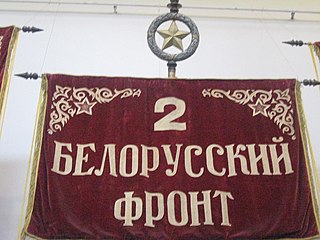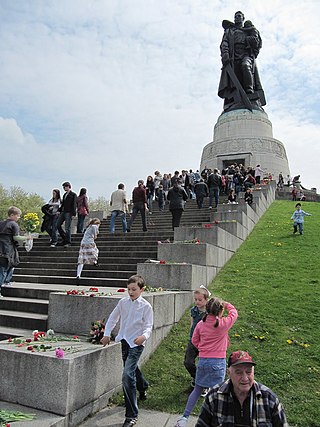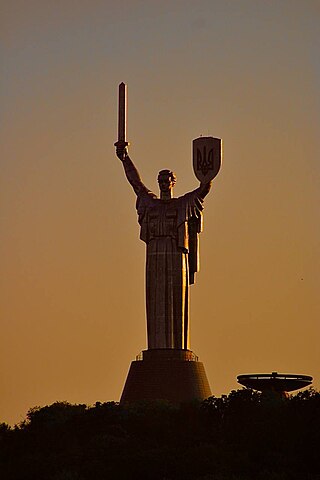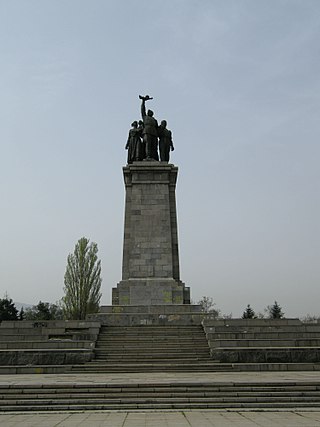
Victory Day is a holiday that commemorates the Soviet Union victory over Nazi Germany in 1945. It was first inaugurated in the 15 republics of the Soviet Union following the signing of the German Instrument of Surrender late in the evening on 8 May 1945. The Soviet government announced the victory early on 9 May after the signing ceremony in Berlin. Although the official inauguration occurred in 1945, the holiday became a non-labor day only in 1965.

The Russian Liberation Army was a collaborationist formation, primarily composed of Russians, that fought under German command during World War II. The army was led by Andrey Vlasov, a Red Army general who had defected, and members of the army are often referred to as Vlasovtsy (Власовцы). In 1944, it became known as the Armed Forces of the Committee for the Liberation of the Peoples of Russia.

Ivan Stepanovich Konev was a Soviet general and Marshal of the Soviet Union who led Red Army forces on the Eastern Front during World War II, responsible for taking much of Axis-occupied Eastern Europe.

2nd Belorussian Front a major formation of the Soviet Army during World War II, being equivalent to a Western army group.

The Prague offensive was the last major military operation of World War II in Europe. The offensive was fought on the Eastern Front from 6 May to 11 May 1945. Fought concurrently with the Prague uprising, the offensive significantly helped the liberation of Czechoslovakia in 1945. The offensive was one of the last engagements of World War II in Europe and continued after Nazi Germany's unconditional capitulation on 8/9 May.

Elbe Day, April 25, 1945, is the day Soviet and American troops met at the Elbe River, near Torgau in Germany, marking an important step toward the end of World War II in Europe. This contact between the Soviets, advancing from the east, and the Americans, advancing from the west, meant that the two powers had effectively cut Germany in two.

The ribbon of Saint George is a Russian military symbol consisting of a black and orange bicolour pattern, with three black and two orange stripes. It appears as a component of many high military decorations awarded by the Russian Empire, the Soviet Union and the current Russian Federation.

The Soviet Banner of Victory was the banner raised by the Red Army soldiers on the Reichstag building in Berlin on 1 May 1945, the day after Adolf Hitler committed suicide. It was raised by three Soviet soldiers: Ukrainian Alexei Berest, Russian Mikhail Yegorov, and Georgian Meliton Kantaria.

The Soviet War Memorial is a war memorial and military cemetery in Berlin's Treptower Park. It was built to the design of the Soviet architect Yakov Belopolsky to commemorate 7,000 of the 80,000 Red Army soldiers who fell in the Battle of Berlin in April–May 1945. It opened four years after the end of World War II in Europe, on 8 May 1949. The Memorial served as the central war memorial of East Germany.

The Soviet War Memorial is one of several war memorials in Berlin, the capital city of Germany, erected by the Soviet Union to commemorate its war dead, particularly the 80,000 soldiers of the Soviet Armed Forces who died during the Battle of Berlin in April and May 1945.

During World War II, the Soviet Union occupied and annexed several countries effectively handed over by Nazi Germany in the secret Molotov–Ribbentrop Pact of 1939. These included the eastern regions of Poland, as well as Latvia, Estonia, Lithuania, part of eastern Finland and eastern Romania. Apart from the Molotov–Ribbentrop Pact and post-war division of Germany, the USSR also occupied and annexed Carpathian Ruthenia from Czechoslovakia in 1945.

Mother Ukraine is a monumental Soviet-era statue in Kyiv, the capital of Ukraine. The sculpture is a part of the National Museum of the History of Ukraine in the Second World War. In 2023, the Soviet heraldry was removed from the monument's shield and replaced with Ukraine's coat of arms, the tryzub.

Bilateral relations exist and existed between Austria and Russia and their predecessor states. Since October 1955, the Republic of Austria maintains the constitutionally-mandated status of neutrality; the country is a founding member of the Organisation for Economic Co-operation and Development (OEEC). Austria joined the EU in 1995. Russia is a permanent member of the United Nations Security Council, a partner of ASEAN, a member of the Shanghai Cooperation Organisation (SCO), the G20, the Asia-Pacific Economic Cooperation (APEC), the Organization for Security and Co-operation in Europe (OSCE), as well as the leading member state of the Commonwealth of Independent States (CIS), the Collective Security Treaty Organization (CSTO), and the Eurasian Economic Union (EEU). Both countries are members of the Organization for Security and Co-operation in Europe and the World Trade Organization (WTO).

The Monument to the Soviet Army is a partially dismantled monument located in Sofia, the capital of Bulgaria. There is a large park around the statue and the surrounding areas. It is a popular place where many young people gather. The monument is located on Tsar Osvoboditel Boulevard, near Orlov Most and the Sofia University. It portrays a soldier from the Soviet Army as a freedom fighter, surrounded by a Bulgarian woman, holding her baby, and a Bulgarian man. There are other, secondary sculptural composition parts of the memorial complex around the main monument, like the group of soldiers which have been used many times as a canvas by political artists. The monument was built in 1954 on the occasion of the 10th anniversary of the liberation by the Soviet Army, which is the general Russian interpretation of the complex military history of Bulgaria during World War II. The monument was partially removed in December 2023.

The Soviet War Memorial in Schönholzer Heide in Pankow, Berlin was erected between May 1947 and November 1949, and covers an area of 30,000 square metres. The memorial contains the largest Soviet cemetery in Berlin, which is also the largest Russian cemetery in Europe outside of Russia.

As Allied troops entered and occupied German territory during the later stages of World War II, mass rapes of women took place both in connection with combat operations and during the subsequent occupation of Germany by soldiers from all advancing Allied armies, although a majority of scholars agree that the records show that a majority of the rapes were committed by Soviet occupation troops. The wartime rapes were followed by decades of silence.

Austria–Soviet Union relations were established in 1924, discontinued in 1938 following German annexation of Austria and renewed following Austrian independence after World War II.

Soviet imagery has been extensively used by Russian forces during the Russo-Ukrainian War, especially following the invasion of Ukraine by Russia on 24 February 2022. Prior to 1991, Ukraine was a member republic of the Soviet Union.




















